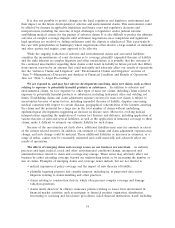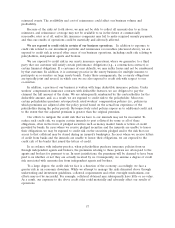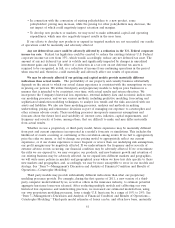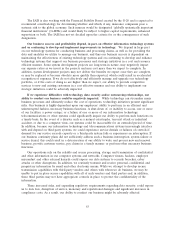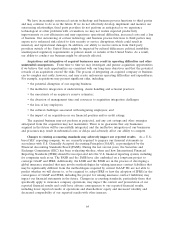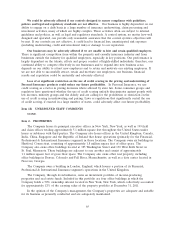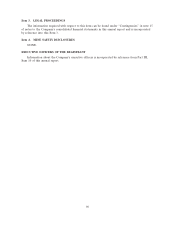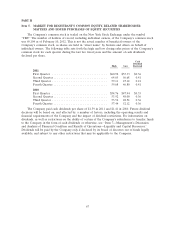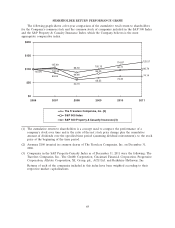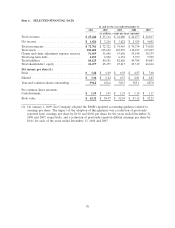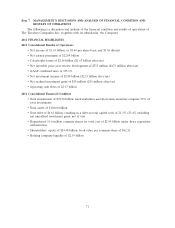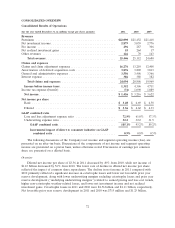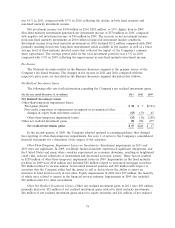Travelers 2011 Annual Report Download - page 76
Download and view the complete annual report
Please find page 76 of the 2011 Travelers annual report below. You can navigate through the pages in the report by either clicking on the pages listed below, or by using the keyword search tool below to find specific information within the annual report.We have increasingly outsourced certain technology and business process functions to third parties
and may continue to do so in the future. If we do not effectively develop, implement and monitor our
outsourcing relationships, third party providers do not perform as anticipated or we experience
technological or other problems with a transition, we may not realize expected productivity
improvements or cost efficiencies and may experience operational difficulties, increased costs and a loss
of business. Our outsourcing of certain technology and business process functions to third parties may
expose us to enhanced risk related to data security or service disruptions, which could result in
monetary and reputational damages. In addition, our ability to receive services from third party
providers outside of the United States might be impacted by cultural differences, political instability,
unanticipated regulatory requirements or policies inside or outside of the United States. As a result,
our ability to conduct our business might be adversely affected.
Acquisitions and integration of acquired businesses may result in operating difficulties and other
unintended consequences. From time to time we may investigate and pursue acquisition opportunities
if we believe that such opportunities are consistent with our long-term objectives and that the potential
rewards of an acquisition exceed the risks. The process of integrating an acquired company or business
can be complex and costly, however, and may create unforeseen operating difficulties and expenditures.
For example, acquisitions may present significant risks, including:
• the potential disruption of our ongoing business;
• the ineffective integration of underwriting, claims handling and actuarial practices;
• the uncertainty of an acquiree’s reserve estimates;
• the diversion of management time and resources to acquisition integration challenges;
• the loss of key employees;
• the cultural challenges associated with integrating employees; and
• the impact of an acquisition on our financial position and/or credit ratings.
The acquired business may not perform as projected, and any cost savings and other synergies
anticipated from the acquisition may not materialize. There is no guarantee that any businesses
acquired in the future will be successfully integrated, and the ineffective integration of our businesses
and processes may result in substantial costs or delays and adversely affect our ability to compete.
Changes to existing accounting standards may adversely impact our reported results. As a U.S.-
based SEC reporting company, we are currently required to prepare our financial statements in
accordance with U.S. Generally Accepted Accounting Principles (GAAP), as promulgated by the
Financial Accounting Standards Board (FASB). During the last several years, the Securities and
Exchange Commission (SEC) has been evaluating whether, when and how International Financial
Reporting Standards (IFRS) should be incorporated into the U.S. financial reporting system, including
for companies such as us. The FASB and the IASB have also embarked on a long-term project to
converge GAAP and IFRS. Additionally, the IASB and the FASB are in the process of developing a
global insurance standard that may involve methodologies for valuing insurance contract liabilities that
may be significantly different from the methodologies required by current GAAP. We are not able to
predict whether we will choose to, or be required to, adopt IFRS or how the adoption of IFRS (or the
convergence of GAAP and IFRS, including the project for valuing insurance contract liabilities) may
impact our financial statements in the future. Changes in accounting standards, particularly those that
specifically apply to insurance company operations, may impact the content and presentation of our
reported financial results and could have adverse consequences to our reported financial results,
including lower reported results of operations and shareholders’ equity and increased volatility and
decreased comparability of our reported results with other insurers.
64


